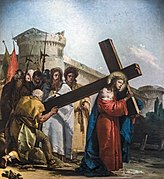San Polo (Venice)
San Paolo apostolo , usually called San Polo , is a church in the Venetian sestiere of San Polo . The building is located on the southeast side of the square, also named after the apostle, the Campo San Polo . The church was one of the parish churches until 1810, but has been under the Frari Church since then .
history
According to tradition, the Veneto-Byzantine church was built at the beginning of the 9th century, either under Doge Pietro Tradonico or under Orso I. Particiaco . The year 837 is considered to be the legendary founding date. The bell tower was built in 1362. Above the entrance are two St. Mark's lions , one of which has a snake in its paws, the other a human head. According to legend, the work is reminiscent of either the tragic end of Doge Marino Faliero (1355) or the end of Condottiere Francesco Bussone da Carmagnola (1432).
In contrast to most of Venice's churches , San Polo was never adapted to the respective time-related style through massive renovations. On the other hand, individual elements were added, such as the Gothic side portal with its cornice band and its floral ornamentation. The pointed arch in the side aisle and the rosette were added at this time . In 1586 the large apse was restored with funds from Giovanni Soranzo .
From around 1799 to 1804 there were significant interventions under the direction of David Rossi . The columns of the main nave were replaced by Ionic columns and classicist elements were introduced in various places . The apse was rebuilt on a semi-octagonal floor plan and arched windows were added. Later restorers removed other elements from the 18th and 19th centuries as far as possible.
Furnishing
On the right between the sacristy windows there are two high reliefs from the 14th century, the Madonna on the throne with the child and Saints Peter and Paul on the one hand and above the baptism of Christ . In 1804 a neoclassical niche was created at the height of the central apse, which contains an Attic marble statue from the 4th century BC. In the first half of the 15th century the head and limbs of St. Paul were incorporated. On the top of the roof behind it rises a statue of the 13th century. It depicts an angel with an incense burner. On the outer wall of the apse (inside is the chapel of the Holy of Holies), two further high reliefs were attached: The Madonna with the child and the believers dates from the early 16th century . Above the shrine , a curtain of the year 1702 opens above a canopy .
The main entrance, which is emphasized by a splendid Gothic frame, is located on the Salizada, which leads south from the Campo, and which is so named because it was paved early on. The main entrance leads to a church with a three-aisled basilica floor plan.
On the wall to the left of the main entrance is a Last Supper by Jacopo Tintoretto , who also created the Assumption of Mary and Saints on the altarpiece of the main altar in 1576-77 ; the pala of the main altar is also attributed to his workshop. The church also contains works by Paolo Piazza (1560–1620): San Silvestro baptizes Emperor Constantine and the prayer of St. Paul ; Added to this is the Sacro Cuore di Gesù from Jacopo Guarana .
The altar in the left apsidal chapel bears the Sposalizio della Vergine by Paolo Veronese , the presbytery works by Jacopo Palma the Younger (including the handing over of the keys to St. Peter , the conversion of Paul and the temptation of Sant'Antonio abate ). There are also the two bronze statues of Alessandro Vittoria San Paolo and Sant'Antonio abate .
In the main nave there are works by an unknown artist from the 19th century depicting the evangelists, as well as scenes from the life of Paul. The master who created the crucifix of the main altar is just as unknown as the creator of the paintings in the right aisle. The Madonna and Child is attributed to Pietro Zandomeneghi .
On the ceiling there is a Gloria degli angeli and a Resurrezione di Cristo by Giandomenico Tiepolo . In contrast, the Pala La Vergine is attributed to Giambattista Tiepolo . The Johannes Nepomuk was the church along with the associated relics by the Polish King Augustus III. donated.
On the main altar side there is the Cappella del Santissimo with works by Giuseppe Porta , called Salviati (approx. 1520-approx. 1575): Christ Carrying the Cross (Walk to Calvary), Descent from the Cross , Christ in the Olive Grove and The Washing of the Feet . The ceiling frescoes are by Gioacchino Pozzoli .
Last Supper by Jacopo Tintoretto
Pala La Vergine Giambattista Tiepolo
- The crucifix oratory
The crucifix oratory, which replaced a Gothic vestibule through which the church could previously be entered, was built after 1505. Giandomenico Tiepolo created a 14-part cycle of paintings here on Via Crucis (1747–49). Other works by Tiepolo in this chapel are: San Filippo Neri , San Giovanni Nepomucieno , the Santi Elena e Macario and San Vincenzo Ferreri .
literature
- Antonio Manno: Venice. National Geographic Germany, 2004, pp. 428–431.
- Marcello Brusegan : Guida insolita ai misteri, ai segreti, all leggende e alle curiosità delle chiese di Venezia. Newton Compton, 2004, pp. 292-294.
Web links
Remarks
- ↑ This is what Pietro A. Pacifico says: Cronica Veneta Sacra e Profana, o sia un Compendio di tutte le cose più illustri ed antiche della Città di Venezia, Pitteri, 1736, p. 351. Marcello Brusegan : I personaggi che hanno fatto grande Venezia. Artisti, letterati, scienziati e avventurieri , Newton Compton, 2006, p. 405 claims, like many authors, this year as a fact.
Coordinates: 45 ° 26 ′ 13.4 ″ N , 12 ° 19 ′ 47 ″ E





















